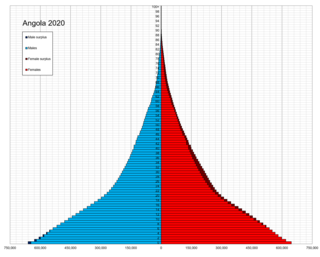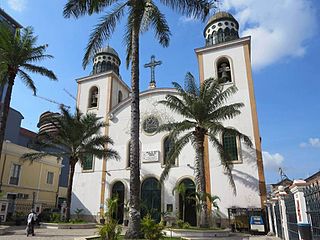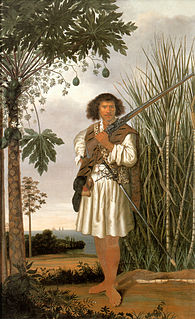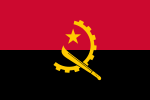
Angola, officially the Republic of Angola, is a country located on the west coast of Southern Africa. It is the second-largest lusophone (Portuguese-speaking) country in both total area and population, and it is the seventh-largest country in Africa, bordered by Namibia to the south, the Democratic Republic of the Congo to the north, Zambia to the east, and the Atlantic Ocean to the west. Angola has an exclave province, the province of Cabinda that borders the Republic of the Congo and the Democratic Republic of the Congo. The capital and largest city is Luanda.

This article is about the demographic features of the population of Angola, including population density, ethnicity, education level, health of the populace, economic status, religious affiliations and other aspects of the population.

This article is about the demographic features of the population of Equatorial Guinea, including population density, ethnicity, education level, health of the populace, economic status, religious affiliations and other aspects of the population.

This article is about the demographic features of the population of São Tomé and Príncipe, including population density, ethnicity, education level, health of the populace, economic status, religious affiliations and other aspects of the population.

Mestizo is a term used in Hispanic America to refer to a person of a combined European and indigenous American descent. The term was used as an ethnic/racial category for mixed-race castas that evolved during the Spanish Empire. Although, broadly speaking, mestizo means someone of mixed European/indigenous heritage, the term did not have a fixed meaning in the colonial period. It was a formal label for individuals in official documentation, such as censuses, parish registers, Inquisition trials, and other matters. Priests and royal officials might label individuals as mestizos, but the term was also used for self-identification.
Mulatto is a racial classification to refer to people of mixed African and European ancestry. Its use is considered dated and offensive. A mulatta is a female mulatto.
Multiracial people are people of many races. Many terms exist for people of various multiracial backgrounds, including multiracial, biracial, multiethnic, polyethnic, Métis, Creole, Muwallad, mulatto, Coloured, Dougla, half-caste, mestizo, Melungeon, quadroon, cafuzo/zambo, Eurasian, hapa, hāfu, Garifuna, pardo and Guran.

The culture of Angola is influenced by the Portuguese. Portugal occupied the coastal enclave Luanda, and later also Benguela, since the 16th/17th centuries, and expanded into the territory of what is now Angola in the 19th/20th centuries, ruling it until 1975. Both countries share cultural aspects: language (Portuguese) and main religion. However, the Angolan culture is mostly native Bantu, which was mixed with Portuguese culture. The diverse ethnic communities with their own cultural traits, traditions and native languages or dialects include the Ovimbundu, Ambundu, Bakongo, Chokwe, Avambo and other peoples.
Goans is the demonym used to describe the people native to Goa, India, who form an ethno-linguistic group resulting from the assimilation of Indo-Aryan, Dravidian, Indo-Portuguese and Austro-Asiatic ethnic and/or linguistic ancestries. They speak different dialects of Konkani natively. Goanese is an incorrect usage for Goans.
Peruvians are people identified with the country of Peru. There were Andean and Coastal Ancient civilizations like Caral, the oldest civilization of Peru and the Americas, who inhabited Peruvian territory for several millennia before the Spanish Conquest in the 16th century; Peruvian population decreased from an estimated 5–9 million in the 1520s to around 600,000 in 1620 mainly because of infectious diseases. Spaniards and Africans arrived in large numbers in 1532 under colonial rule, mixing widely with each other and with Native Peruvians. During the Republic, there has been a gradual immigration of European people. Chinese and Japanese arrived in large numbers at the end of the 19th century.

Brazilians are the citizens of Brazil. A Brazilian can also be a person born abroad to a Brazilian parent or legal guardian as well as a persons who acquired Brazilian citizenship. Brazil is a multiethnic society, which means that it is home to people of many ethnic origins. As a result, a majority of Brazilians do not identify their nationality as not being necessarily directly related to their ethnicity; in fact, the idea of ethnicity as it is understood in the anglophone world is not popular in the country.

Portuguese Angolan is a person of Portuguese descent born or permanently living in Angola. The number of Portuguese Angolans dropped during the Angolan War of Independence, but several hundreds of thousands have again returned to live and work in Angola in the 21st century.

Mestiço, in Colonial Brazil, was initially used to refer to mamelucos, persons born from a couple in which one was an Indigenous American and the other a European. It literally translates as "mameluke", probably referring to the common Iberian comparisons of swarthy people to North Africans.

Christianity in Angola has existed since 1491. Today 80% of Angolans practise some form of Christianity.

Religion in Angola consists in about 1,000 religious communities in the country, most of which are Christian. Roman Catholics constitute about half of the population. Other Christian denominations include Baptists, Methodists, Congregationalists, Lutherans, Reformed Churches and Seventh-day Adventists and Jehovah's Witnesses − all these denominations making up about a quarter of the population. Since independence, numerous Pentecostal, Evangelical and other communities have sprung up, the most important being the Igreja Universal do Reino de Deus, of Brazilian origin. Two syncretic "African Kala Christian" churches exist, the Kimbanguists who have their origin in what is the present-day Democratic Republic of Congo, and the indigenous Tokoist faith. There is also a small Muslim minority, consisting of Sunni immigrants from a diversity of African and other countries, who do not form a community. Some Angolans − mostly in remote rural societies − currently profess African Traditional Religions, but traditional beliefs subsist among a substantial part of those who have become Christians.
White Africans of European ancestry, or Euro-Africans refers to people in Africa who can trace full, or partial ancestry to Europe. In 1989, there were an estimated 4.6 million people with European ancestry on the African continent. Most are of Dutch, British, Portuguese, German, and French descent; and to a lesser extent there are also those who descended from Italians, Spaniards, and Greeks. The majority once lived along the Mediterranean coast or in Southern Africa. The earliest permanent European communities in Africa were formed at the Cape of Good Hope; Luanda, in Angola; São Tomé Island; and Santiago, Cape Verde through the introduction of Portuguese and Dutch traders or military personnel. Other groups of white settlers arrived in newly-established European colonies in Africa. Before regional decolonisation, white Africans may have numbered up to 6 million persons and were represented in every part of the continent.
Luso-Indian or Portuguese-Indian, is a subgroup ethnicity from Luso-Asians and are people who have mixed varied Indian subcontinent and Portuguese ancestry or people of Portuguese descent born or living in the Republic of India and the world. Most of them live in former Portuguese overseas territories of the Estado da India which are currently a part of the newly formed independent nation as a Union in 1947 called the Republic of India from British raj. Luso-Asians of the Indian subcontinent are primarily from Goa, Mangalore, Daman and Diu, Korlai (Chaul), Bassein, Silvassa, Tamil Nadu and Kerala. There are also a number of Indians with Portuguese names who do not possess European ancestry, being named as such in the process of their conversion to Roman Catholicism by Portuguese missionaries in the sixteenth century. This was done to prevent caste-based discrimination among the native converts. Nevertheless, they are in many cases indistinguishable from the wider Luso-Indian population.
There are light-skinned or White Angolans mostly Angolans of European descent most significantly from Portugal. The vast majority of white settlers in Angola have been of Portuguese ancestry, both in colonial days and today. Germans and Afrikaners settled in southern parts of Angola, with Germans concentrated in Moçamedes and Benguela and Afrikaners concentrated in Huíla Province. Most Afrikaners and Germans left for Namibia and South Africa by 1975. Until 1975 there was a German-language school in Benguela called the Deutsche Schule Benguela.
Luso-Africans are people of mixed Portuguese and African ancestry who speak Portuguese. The vast majority of Luso-Africans live in former Portuguese Africa, now referred to as Lusophone Africa, comprising the modern countries of Angola, Guinea-Bissau, Cape Verde, Mozambique, São Tomé and Príncipe, and Equatorial Guinea. A sizable number of Luso-Africans have also settled in Portugal where they form a racial minority. This ethnic identity arose from the sixteenth century as primarily male Portuguese settlers, often Lançados, settled in various parts of Africa, often marrying African women.










